The Green Man & the Green Woman By Ko Lankester,
Photographs Joke Lankester
It is one of the mysteries of life that a foliate figure confronts us when we visit museums, churches or palaces. Many people have noticed them since Lady Raglan published her famous article The Green Man in 1939. It was Marian Green (!) who first called the Green Man to our attention when she told Joke about this phenomenon during a summer week in Holland in 1989. Two years later Marian showed us the four Green Men that have watched over the tomb of Lord Berkeley and his mother since 1337 in Bristol Cathedral. One of them has leaves growing out of his beard, covering his head.
Green Man Bristol Cathedral
Since then we have been fascinated by this enigmatic character, watching out for him on our trips all over Europe. We were in for some surprises. We discovered the Green Man often has a body, and is not just a head, as many people think. We also stumbled upon many Green Women, although hardly anybody seems to have noticed them to this day. Since Lady Raglan’s article a Green Man was supposed to be the head of a man. Period. We were mesmerized by this dictum for years, just looking for Green Men, not women, not recognising them when we encountered them. In fact, when we visited England in 1991, Joke took a photograph of a Green Man roof boss in Canterbury Cathedral, manufactured between 1379 and 1400, stems and leaves issuing from the corners of his mouth. It took us years to notice that the figure in the centre of the vault is a Green Woman. Her head is surrounded by leaves and flowers. If you don’t expect stems and leaves flourishing from the mouths of Green Women then you will miss them, or dismiss them as just women, or saints, as is often done.
2 Green Man & Green Woman Canterbury Cathedral
The Roman Green Man and Green Woman
In 2011 A3-Boeken published our book De Groene Man en de Groene Vrouw, the result of twenty years of research all over Europe. After summarising Greek prototypes we described how the Green Man and the Green Woman emerged from the Roman Republic in the first century BC. Often Greek artists, being the expert sculptors, created the images, but they never depicted Green Men or Green Women before the Romans turned the Hellenistic world into a collection of Roman provinces. Since the first century BCE wealthy and powerful Romans told poor Greek artists what they wanted. It is true that the Romans admired the way the Greeks depicted their Gods and Goddesses and as a rule Greek sculptors were free to design Roman Gods and Goddesses as their Greek equivalents. But the Romans also liked the way Roman painters had embellished the houses, temples and palaces of Rome with strange creatures, partly human, partly animal and partly vegetable. In 25 BCE the Roman architect Vitruvius published his book on architecture and he complained how Roman painters had sacrificed reality, creating a myriad of frescoes populated with monsters, their heads or upper bodies emerging from vegetation, balancing on candelabra, consisting of fragile stems, supporting temples and other objects that seemed to float in the air. These structures Vitruvius deemed impossible to build, so they had nothing to do with reality, and art, the master tells us, should imitate the reality of nature.
Nero was particularly fond of the scenes Vitruvius detested. Between 64 and 68 AD he built the Domus Aurea (Golden House), a gigantic palace in Rome, and had all the walls, corridors and vaults decorated with frescoes featuring candelabra, men, women and animals emerging from vegetation. After the emperor had been forced to commit suicide because of his disgraceful behaviour his palace was filled with rubble, walled up and covered with the public Baths of Titus. The frescoes with candelabra and fantastic creatures were associated with the hated Nero and removed from the walls of Rome. Not many frescoes have survived this clearance, but the Palazzo Massimo alla Terme in Rome has reconstructed the Villa Farnesina, decorated in 19 BCE, displaying many frescoed rooms. One of the frescoes displays a candelabrum, formed by a plant and three creatures growing out of it. In the middle a Green Woman emerges from a bud. The lower part of her body seems to be part of the plant. From the waist up she is a female, but the stalks emanating from the top of her head underline her vegetable roots. Again the structure on her head is a sort of crown, revealing her royal status. The plant underneath her forms two volutes out of which two white creatures grow. The woman stretches her hands lovingly towards them, apparently to bless or feed them. The fresco displays in a nutshell the role of the Green Woman throughout the ages: she rules the other world, a realm where there are no strict boundaries between divine, human, animate or inanimate beings.
3 Rome Palazzo Massimo Villa Farnesina
The lower half of the body of the Roman Green Woman sometimes consists entirely of leaves. So she is free to move, not tied to the soil, while at the same time she displays her connection to the vegetable kingdom. Above the gate of the Temple of Hadrian in Ephesus (Turkey), 118 AD, a Green Woman watches over the deified emperor. The snakes in her hair identify her as Medusa, the Goddess who takes care of the deceased and is often depicted as a caring (not evil) Goddess on Greek and Roman sarcophagi. Beneath the waist, however, her body is made up of acanthus leaves from which two horns of plenty emerge.
4 Ephesus Medusa as Green Woman Temple of Hadrian
The Green Man with stems issuing from his mouth or with leaves growing on his face was contrived by the Romans and spread across the Roman republic and empire. A marble slab, on display in the garden of the archeological museum at Antalya (Turkey), probably from the second century AD, shows a face with acanthus leaves growing all over it. The hollow eyes indicate a theatre mask which was depicted on a sarcophagus.
5 Green Man in Museum Antalya
The oldest Green Man found on Dutch territory was made between 150 and 250 AD on the side of an altar for the Goddess Nehalennia, a votive offering by the Roman Sextus Severinus Severus for the temple of Nehalennia near Colijnsplaat in Zeeland. On the altar the Goddess sits on her throne, between her dog and a basket filled with fruits, a tray with more fruits on her lap. On the left side of the altar a Green Man is depicted, acanthus leaves covering his face. The altar is on display in the archeological museum RMO in Leyden.
6 RMO Green Man at Nehalennia.
The Romanesque period
The Green Man and the Green Woman emerged in pagan Europe. So they were bound to disappear when the Roman Empire was first converted to Christianity and then fell apart when the last emperor was deposed in 476. Until the 6th century Green Men were portrayed incidentally on capitals, following Roman examples, and then they disappeared from the scene. When they reappeared in the 11th century it was not in a pagan or secular setting, but in Romanesque churches, especially in France, but in other European countries as well.
Scholars often tell us Romanesque images teach the simpletons in their congregation to choose between the blessings of Heaven and the monsters and tortures of hell. Books about Romanesque churches carefully display the two extremes. However, medieval men and women were not that straightforward. They believed in a world full of miracles and mysterious events, a universe in which the divine could take many forms. What seemed to be a beggar or a monster could be an epiphany of the divine. What looked like the gates of Heaven could lead you to a bottomless pit. Romanesque images, weird and wild, served to open up a strange and enigmatical world, a universe in which the Green Man and Green Woman seemed to be at home.
In Romanesque churches the Green Man often takes his abode in capitals. In the abbey of St George in Saint Martin de Bosscherville, built around 1180, a Green Man stares at us in the Chapter House. Leaves issue from his mouth, forming a typically Romanesque palmette underneath and volutes on the sides. There are many others like this in the abbey and myriad Romanesque churches in France and elsewhere.
7 GM in St Martin-de-Bosscherville
The image in Saint Martin de Bosscherville may seem crude and bestial, but Romanesque Green Men are not always like that. In 1135 the Holy Roman Emperor Lothair III ordered the building of an imperial dome in Königslutter, in which he and his wife are buried. On the outside of the choir a dignified Green Man is depicted, leaves growing from his beard and moustache. The stern look in his eyes gives him an imperial authority, overlooking the world between the worlds, the limitless realm.
8 GM Königslutter
His creative power is displayed in another image, in which dragons issue from his mouth.
9 GM Königslutter
The dragons are not the monsters that contemporary scholars claim serve to warn simpletons of the horrors of hell. There are other dragons on the choir and in the adjacent cloister, and they are beautiful, vigorous creatures, some with a human head, and some with animal features.
In the Romanesque age the Green Woman is not as conspicuous as the Green Man, but she is not absent. Often she is the counterpart of the Green Man, the two of them occupying both ends of an arch. In the church of Saint Germain des Prés in Paris (12th century) she is depicted as sovereign of the other world. On one of the polychrome capitals two winged dragons and two birds worship the Green Woman amid palmettes.
10 Green Woman in St Germain des Pres
We know she is the Green Woman because another capital shows the very same woman with palmettes issuing from her dress.
Romanesque Green Men may be found on the façade of churches, on capitals, keystones, cornices, porches, tympanums, and baptismal fonts. Secular buildings in that age are mostly unadorned and the Green Man and Green Woman are not displayed in them. From the 7th century onward illuminated manuscripts used initials to delineate the fascinating sphere between the worlds of God and man, the realm where the Green Man and Green Woman were at home.
The Green Man and the Green Woman in the Gothic Age
The Gothic Green Man is a phenomenon most people are familiar with: a foliate head, sometimes with vegetation emanating from his mouth. In Chartres Cathedral, erected between 1200 and 1225, three Green Men support corbels in the southern porch. In the middle a Green Man has acanthus leaves growing from his beard and nose. The Green Man on his left produces oak leaves and acorns; the one on his right vines with bunches of grapes.
11 Chartres 3 Green Men on southern porch
The northern porch of Chartres Cathedral displays three Green Women amid oak leaves.
12 Chartres 3 Green Women on northern porch
Although there is no foliage growing on their faces or issuing from their mouths, the oak leaves and the presence of their male counterparts in the southern porch identify them as Green Women.
In many ways Gothic architecture is a restrained version of the unbridled Romanesque wilderness. Gothic churches strictly distinguish between Heaven, Hell and the world of man. Ecclesiastical and secular leaders represent the latter. Christ and the Holy Virgin show you the way to Heaven, assisted by saints and Church Fathers. Christ also represents the Last Judgment, in which sinners are banished to eternal damnation. The Green Man and the Green Woman stood their ground, adapting to the changed environment. Romanesque vegetation is crude and stiff. Gothic artists refined their botanical depictions and the Green Man and the Green Woman profited from it – as the examples from Chartres show. The façade of the churches they had to abandon, but they retained the roof bosses, as the photograph from Canterbury illustrates.
Generally speaking the Green Man was pushed back in Gothic churches, compared with the Romanesque period, while the Green Woman all but disappeared. The Green Women in Chartres are exceptional. However, there is one place in Gothic Churches that did give shelter to the Green Man and the Green Woman, a new phenomenon: the misericord. This is a narrow ledge underneath the seats in a choir stall. When the seat is turned up the misericord provides support to one while standing. Although misericords are new they are the only places in Gothic churches reminiscent of the Romanesque wilderness, a doorway to the realm between the worlds of God and man. Many misericords are enigmatic, blocking rational explanations, prying open your basic instincts, which may be the only way to approach the divine. One misericord from Barcelona Cathedral, made between 1394 and 1399, may serve to illustrate this point.
13 Barcelona misericord
From a pot in the middle long leaves grow. In the middle a young man (left) and a woman (right) emerge from the vegetation. They lovingly embrace each other. Grape or ivy leaves on their heads emphasize they are a Green Man and a Green Woman. On the sides two other persons arise, their heads covered with leaves. The left one seems to be a man, the right one a woman. They emerge from the vegetation, being a Green Man and a Green Woman. The man has raised his right leg and seems to ponder the possibility of stepping out. But the leaves on his belly mark him as a Green Man, so he may not be able to step out and join the world of man. Writers on the subject often characterize misericords as funny, and that they certainly are, but most are also enigmatic and fascinating.
The Renaissance Green Man and Green Woman
In the 15th century Gothic architecture was gradually replaced by a new style, based on Roman art: the Renaissance. One important renewal, coffering the ceilings, instead of covering them with a vault, proved detrimental to the Green Man and Green Woman, as it discarded both corbels and roof bosses, the traditional abode of the Green Man and Green Woman. Tracery, the typical Gothic ornaments, with their trefoil or quatrefoil openings, which often displayed a Green Man in the middle, was considered outdated and dropped from architectural designs.
So the Green Man and the Green Woman lost their homes. They could have disappeared forever if the Domus Aurea had not been rediscovered in 1480. Some people in Rome discovered rooms and corridors underneath the ground, embellished with many fascinating frescoes. Until the 19th century the rooms were held to be part of the public baths Titus had built. Painters and sculptors were lowered down into the ‘Baths of Titus’ and they were astonished by the quality of the frescoes and even more so by the strange creatures they found depicted. As the subterranean rooms reminded them of a grotto the creatures were dubbed grotesques. And that is the name that has been used to indicate the Green Man and the Green Woman until Lady Raglan renamed them as Green Man. Among the artists visiting the place were Barnadino Pinturicchio and Raphael with the sculptor Giovanni da Udine. All three have been employed by popes and cardinals and the prelates were fascinated by the grotesques, which were considered typically Roman ornaments. Roman paintings were virtually unknown at the time and since the church claimed to be heir to the great Roman Empire the images were deemed essential to revive Roman glory. Artists lavishly copied the frescoes and within decades grotesques spread like wildfire across Europe. The Green Man and the Green Woman were back, more glorious than ever.
(Continues in part II).
Ko & Joke Lankester

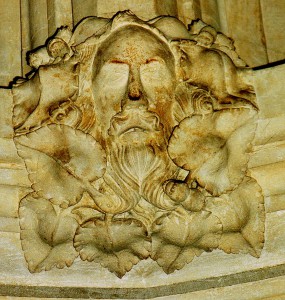
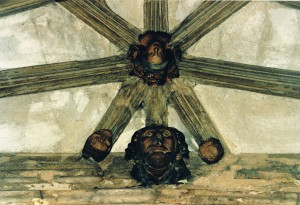
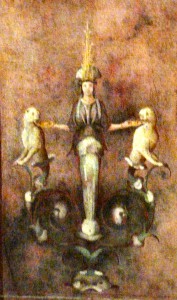
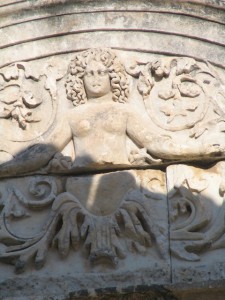
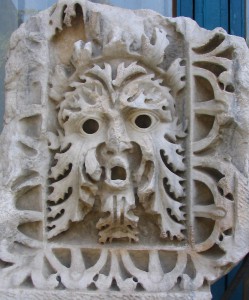
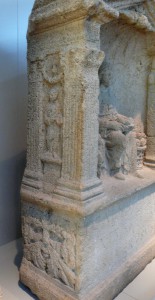
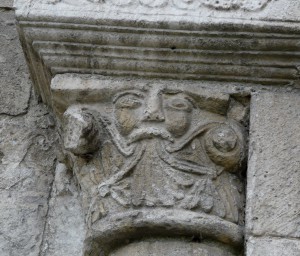


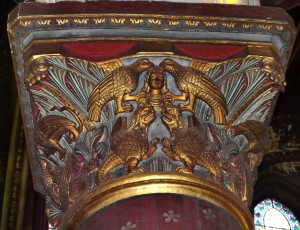
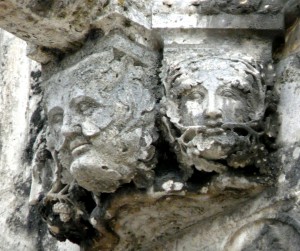
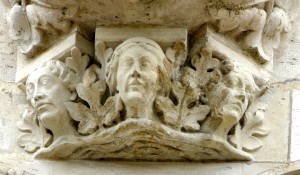
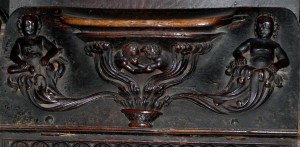
Joke en Ko, opnieuw vind ik jullie ontdekking verbazend van de groene man én de groene vrouw. Het is als het ware een groene lijn door eeuwen heen, de verbondenheid van alle aardse wezens met de aarde. Prachtige beschrijvingen en foto’s.